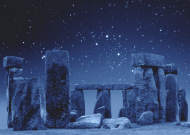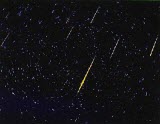Mercury rushes up into the evening twilight sky from mid January until the first week of February [Read more about January 2014 Planetary Skylights ]
 The Sun reaches its lowest position in the sky on December 21st this year - the date of the winter solstice, when the Sun arcs just over 12 degrees above S horizon at local noon. The northern hemisphere is then tilted away from the Sun and useful daylight amounts to just 7½ hrs: the shortest day. [Read more about The Winter Solstice]
The Sun reaches its lowest position in the sky on December 21st this year - the date of the winter solstice, when the Sun arcs just over 12 degrees above S horizon at local noon. The northern hemisphere is then tilted away from the Sun and useful daylight amounts to just 7½ hrs: the shortest day. [Read more about The Winter Solstice]
- Log in to post comments
 Considered now to be the most prolific annual meteor shower, the Geminids are active from December 7-16, reaching a peak this year in the early morning hours of December 14th. Unlike other showers, Geminids stem from debris shed by a small asteroid called Phaethon, which passes within 10 million miles of the Sun. [Read more about Meteor Activity - December 2013]
Considered now to be the most prolific annual meteor shower, the Geminids are active from December 7-16, reaching a peak this year in the early morning hours of December 14th. Unlike other showers, Geminids stem from debris shed by a small asteroid called Phaethon, which passes within 10 million miles of the Sun. [Read more about Meteor Activity - December 2013]
- Log in to post comments
At the time of the December newsletter, Comet ISON may already a news worthy item - or not. Comet ISON reached perihelion on Nov 28th when it slung shot around our Sun - just 750,000 miles above its surface at an astonishing 845,000 miles per hour. If the comet has not totally fragmented it may be a spectacular sight during the first week of December - or at least the tail of it will be, either just after sunset over in the SW, quite close to Venus, and also just before sunrise over in the SE and near Saturn. [Read more about Comet Ison ]
- Log in to post comments
 We announced in our December Newsletter that the Society's new and improved web site should be available to peruse by the time our December notes reach you, and here it is! Andi Ye and his team have done a sterling job building the new site, which has many new features.
We announced in our December Newsletter that the Society's new and improved web site should be available to peruse by the time our December notes reach you, and here it is! Andi Ye and his team have done a sterling job building the new site, which has many new features.
There will be regular new content on all sorts of subjects, so bookmark the site in your browser, and keep coming back! And it's not just a one-way information feed: you're welcome to add your comments to any article and start a discussion. You can post anonymously or - better yet - create yourself an account and enjoy full site access. [Read more about New Website]
- Log in to post comments
Venus dominates the SW evening twilight sky - visible low above the horizon for an hour or so. As the month progresses Venus gains a little in altitude and grows even brighter attaining -4.5 by Christmas. The moon lies above right on the 5th. [Read more about Planetary Skylights - December 2013 ]
- Log in to post comments
The Leonids are active from Nov 15-20 and will peak this year during the very late evening of Nov 17, which means the early morning of the 18th will be the optimum time to view. Rates are expected to be normal, ie around 15-25 per hour.
Keep an eye out for a few meteors on the night of Nov 4/5th when the South Taurid meteor shower reaches a peak, and then again on the night of Nov 11/12 when the North Taurid meteor shower peaks. Hourly rates for both showers are not more than half a dozen; however Taurids can be bright and produce the occasional spectacular fireball. [Read more about Meteor Activity - November 2013]
- Log in to post comments
Initially dubbed as being the "comet of the century" after its discovery in September of 2012, and then almost being written off as ISON failed to brighten as predicted (no surprise there then) It now appears ISON may be worth watching for after all. [Read more about Comet ISON]
- Log in to post comments
Venus keeps ahead of the sun and actually gains a little in altitude as November progresses. Look for it low above the SW horizon 45 mins after sunset. A crescent moon passes above Venus on the Nov 6th & 7th.
Conspicuous Jupiter continues to rise earlier and is visible low in the east by 9pm at the start of November. It is situated below the 'twin' stars of Gemini. Jupiter is always well worth a view through any telescope. The moon lies below right on Nov 21st. [Read more about Planetary Skylights - November 2013]
- Log in to post comments
Planetary Highlights
Venus continues to linger in the evening twilight very low in the SW sky, though you need to look no more than 40 minutes after sunset. On the 16th it lies above Antares in Scorpius, whilst on the 8th a crescent moon lies above. [Read more about October 2013]
- Log in to post comments

